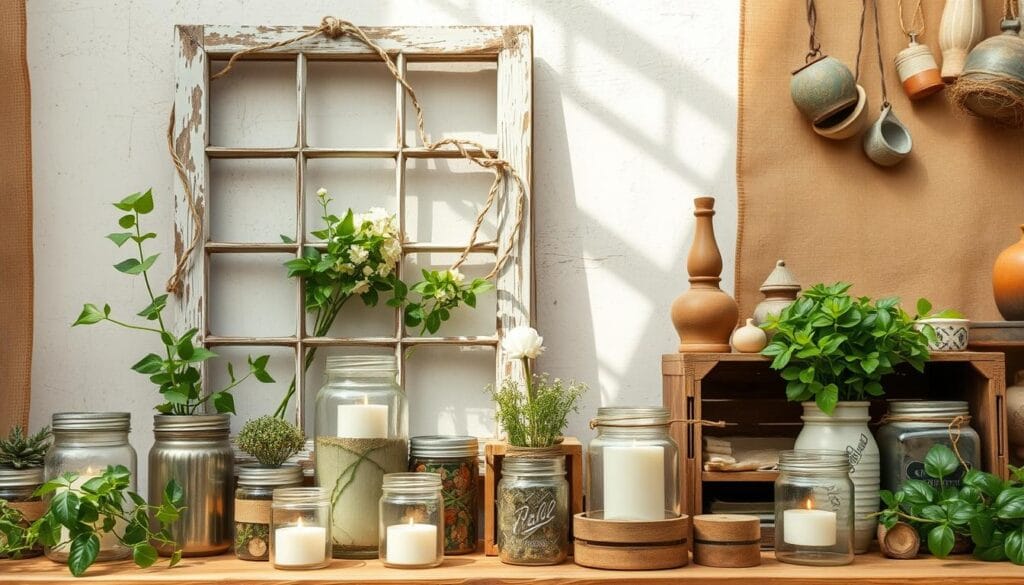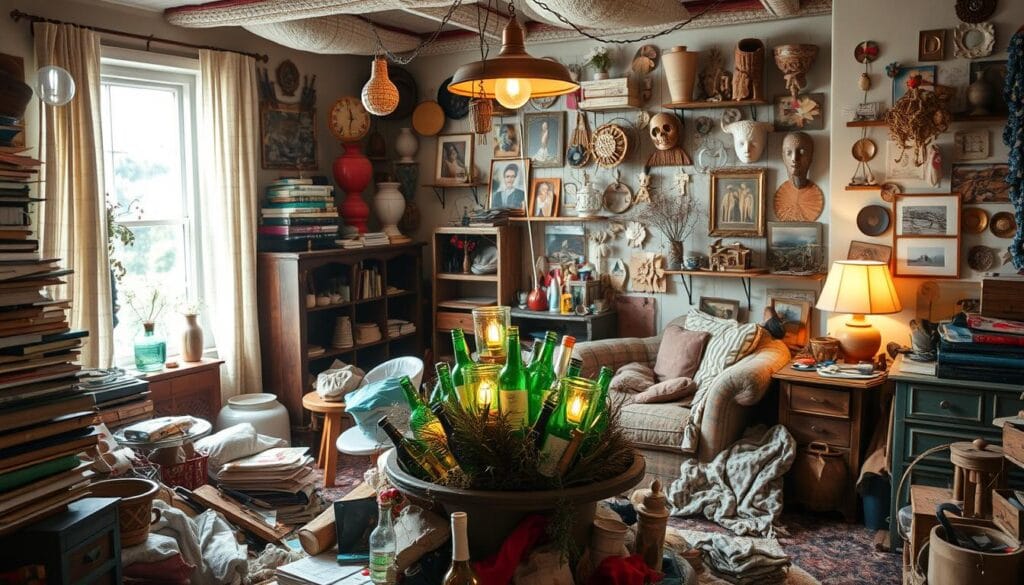Imagine transforming an old item into a beautiful home decor piece. You stand in your kitchen, glass jar in hand, thinking of its potential. This is the beginning of Eco-Friendly DIY.
We’ve all paused before throwing away an old t-shirt or scrap fabric, wondering if it might be useful. The truth is, it can! With creativity and inspiration, we can turn these items into amazing home accents. This gives new life to things that were once trash.
Doing this allows us to create homemade decorations that are special. It also supports sustainable decor by cutting down on waste and encouraging recycling. The market for such upcycled products was worth about $10 billion in 2021. This shows more people are choosing sustainable goods. By adopting recycled crafts, we help this positive trend and make a real impact.
Key Takeaways
- Eco-Friendly DIY helps turn discarded items into beautiful home accents.
- Upcycling promotes sustainable home decor and reduces waste.
- The market for upcycled products is growing, reflecting increased interest in sustainable living.
- Recycled crafts contribute to reducing environmental pollution.
- Creating homemade decorations is both cost-effective and environmentally friendly.
Understanding the Importance of Upcycling
Have you ever thought about the waste you make and its impact on the planet? Upcycling projects are a great solution! By turning old items into valuable new ones, upcycling helps us care for the earth.
What is Upcycling?
Upcycling is turning old, unused things into something new and better. It’s different from recycling because it makes the items more valuable, not lesser. It’s a great way to add personal touch to your home and help the environment. Upcycling furniture is one example. It creates unique decor, tells a story, and keeps things out of landfills.
Environmental Benefits of Upcycling
Upcycling is great for managing waste effectively. Every year, the U.S. throws away about 9.1 million tons of furniture. Upcycling can lessen this by making materials last longer. It also cuts down on pollution from making new items and saves energy. Plus, it helps save resources by lowering the need for new materials, reducing pollution and landfill overflow.
Economic Advantages of DIY Projects
Upcycling not only brings a sense of achievement but also saves money. Whether it’s old furniture or daily items turned into decor, you can keep more cash in your pocket. Upcycling furniture can save you thousands. It’s also cost-effective, saving 50-80% compared to buying new. The demand for upcycled goods is growing, and by 2027, it’s expected to reach $410 billion. This creates a big chance for hobbyists to earn from their crafts.
Common Household Items to Upcycle
Many of us find everyday items at home that can become new, useful things. Upcycling sparks creativity and supports a green way of life. It shows us how to use common items we already have to welcome green living and get creative with recycling.
Glass Jars and Bottles
Glass jars and bottles can be turned into many fun things. They can become elegant candle holders or chic planters. You can even make old wine bottles into vases or lights for your table. These easy projects add style to your home and help the planet too.
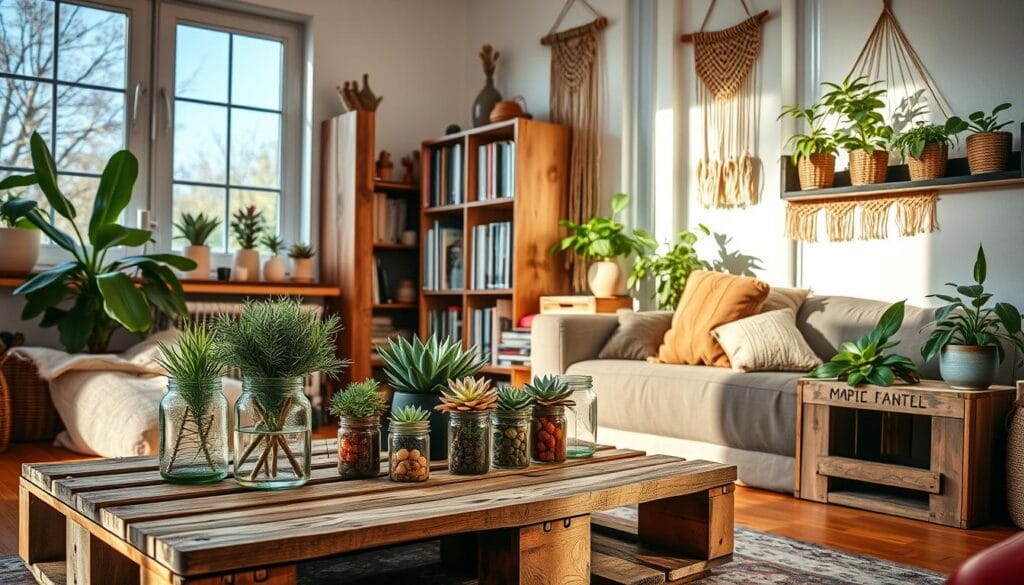
Upcycling lets you add your personal touch. You might wrap jars in jute rope or paint them for a one-of-a-kind look. These projects are budget-friendly, perfect for those who love DIY crafts.
Old Furniture Finds
Refurbished furniture can really change the look of a room. Painting wooden chairs or fixing up an old sofa can save money and be rewarding. For instance, sprucing up a dresser might take a couple coats of paint and some drying time but it’s worth it for a fresh look.
Repurposing old drawers as under-bed storage is a smart and stylish idea. It adds more storage and a personalized touch to your bedroom.
Fabric Scraps and Textiles
Old clothes or extra fabric can turn into new, useful items. Making old jeans into shorts can update a wardrobe without spending much. Or, sewing fabric into reusable bags can cut down on plastic use.
Creating art with fabric scraps adds a unique touch to your space. These projects are eco-friendly and show off the beauty of recycled materials. They encourage living in a way that’s kinder to the earth.
DIY Projects for Glass Jars
Glass jars can make your home look nicer by turning them into beautiful homemade decorations. You can create elegant candle holders or stylish planters. These projects cut down on waste and spark your creativity. They also give you a fun crafting experience.
Creating Elegant Candle Holders
Turning glass jars into candle holders is a simple yet lovely project. You can decorate them with lace, paint, or small stones to make any room cozy. These handmade decorations add a warm, welcoming vibe to your space.
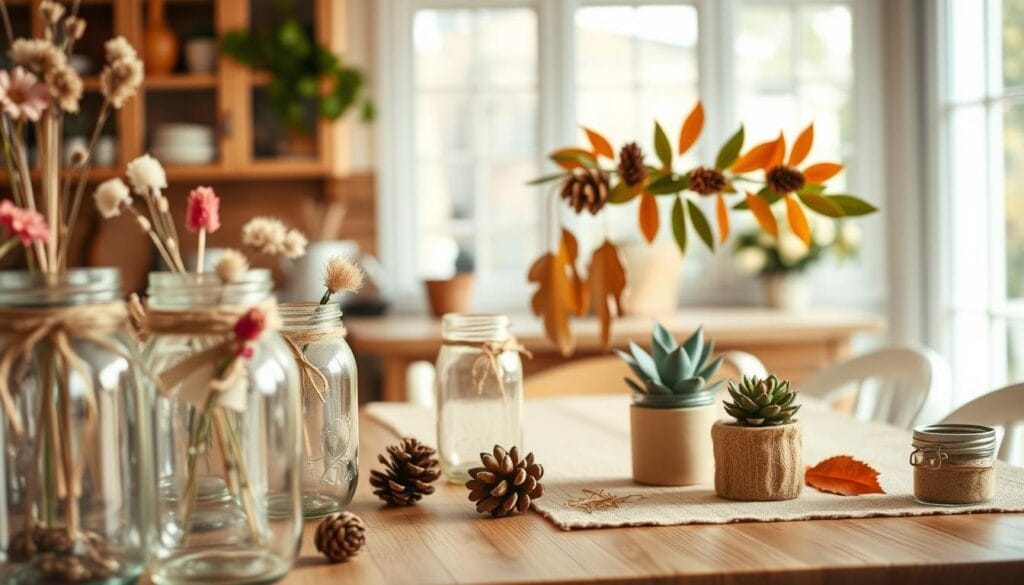
Transforming Jars into Stylish Planters
Using glass jars as planters brings nature into your home. Just fill them with soil and your favorite plants. It’s a trendy way to decorate and great for those living in cities.
Making Unique Storage Solutions
Glass jars aren’t just for looks; they’re also practical. They’re great for storing small things like buttons or spices neatly. Decorating these jars can help organize your space while keeping it beautiful. Upcycling jars for storage is popular because it combines usefulness with style.
| DIY Project | Materials Needed | Time Required | Popularity Increase |
|---|---|---|---|
| Candle Holders | Glass Jars, Paint, Lace, Stones | 2 hours | 50% |
| Stylish Planters | Glass Jars, Potting Soil, Plants | 1 hour | 25% |
| Storage Solutions | Glass Jars, Labels, Paint | 3 hours | 40% |
Upcycling Old Furniture
Diving into upcycling old furniture is exciting! Transforming unwanted pieces into stylish, new items for your home is rewarding. It’s all about using eco-friendly ways to give old furniture a new lease on life. This adds a special touch to any room.

Refurbishing Wooden Chairs
Refurbishing wooden chairs is a fun project for the weekend. Some effort and creativity can turn old chairs into lovely, updated home pieces. First, sand the wood to take off old finishes and show the natural grain. Then, eco-friendly stain or paint can make them look new again. Upcycling is good for the planet and makes your living space more vibrant.
Painting Dressers for a Modern Look
Painting an old dresser can hugely update its look. Pick colors that match your room’s vibe. Use low VOC paints for an eco-friendly approach. These simple steps can change your old dresser into a stylish piece while being mindful of waste.
Converting Crates into Coffee Tables
Wooden crates have many uses, including turning them into attractive coffee tables. Smooth the edges by sanding, then paint or stain the wood. Add some legs or casters, and you’ve got a focal point for your living area. It’s a creative way to support sustainability.
Upcycling is not only good for your home but also great for the planet. It helps keep about 12 million tons of waste out of landfills in the U.S. each year. And it can cut the carbon footprint of making new furniture by up to 80%.
| Benefit | Impact |
|---|---|
| Waste Reduction | 12 million tons diverted from landfills annually in the U.S. |
| Carbon Footprint | Reduces carbon footprint by up to 80% |
| Cost Savings | 50% cost reduction compared to purchasing new |
| Materials Conservation | Up to 90% energy savings using reclaimed materials |
| Indoor Air Quality | Eco-friendly paints reduce pollution by 50% |
These projects are great for the environment and your wallet. They also let you express yourself creatively and feel fulfilled. Upcycling old furniture benefits everyone.
Crafting with Fabric Scraps
DIY projects with eco-friendly ideas make for a creative journey. They give new purpose to fabric scraps. By making things like throw pillows, reusable grocery bags, or wall art, those leftovers become charming and useful home decorations.
Designing Beautiful Throw Pillows
Turning fabric scraps into colorful throw pillows is fun. You can mix textures and patterns for unique designs. A simple method like patchworking can add color and warmth to any room.

Sewing Reusable Grocery Bags
Making reusable grocery bags from fabric scraps is another great idea. These bags are not only good for the environment but also durable and stylish. About 85% of textiles end up in landfills, so this project helps us live more sustainably. Plus, it offers a way to cut down on plastic use.
Creating Wall Art with Fabric
You can also create beautiful wall art with fabric scraps. Try making fabric collages, framed patches, or abstract canvases. These projects let you be creative while helping the planet. They add a unique and cozy feel to your home.
Incorporating these ideas, we help the environment and enjoy making eco-friendly DIY crafts. These projects are not only creative but also make our homes more stylish.
Eco-Friendly Paint and Finishes
Decorating our homes with sustainable materials is now a mindful choice. It’s all about choosing eco-friendly paints and finishes to help the planet. When we use repurposed materials, picking non-toxic, eco-friendly paints is key for our health and Earth.
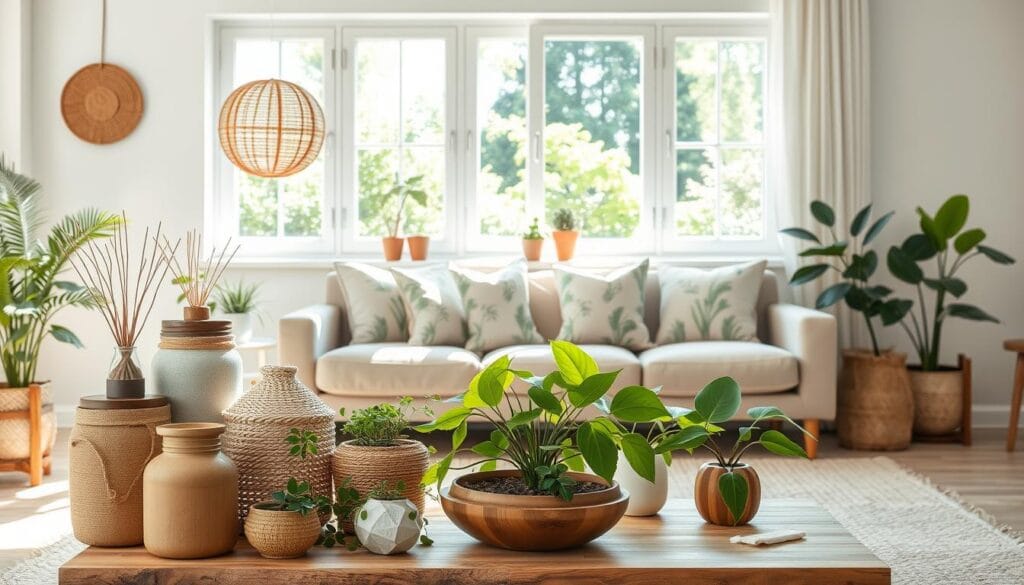
Choosing Non-Toxic Paints
To pick the right eco-friendly paints, it’s important to know about non-toxic options. Eco-friendly paints have low or no VOCs, unlike regular paints. Brands like Behr Premium Plus and Real Milk Paints have Greenguard certification for better indoor air. Plus, water-based paints are easier to clean and better for the environment.
The demand for these paints is growing, with a CAGR of 5.3% from 2021 to 2028. This shows more people are choosing sustainable options.
Natural Finishing Techniques
Using natural finishes makes your home more eco-friendly. Products like Rubio Monocoat offer strong coverage with less waste. Quick-drying, low-VOC water-based varnishes and stains are great for indoor use. Milk paint is another green choice, made from milk protein and natural pigments. These options are good for the planet and look great too.
Tips for Eco-Conscious Decorating
It’s essential to stay green when decorating with reused materials. Here are some tips:
- Research Eco-Labels: Look for Green Seal, Greenguard, and LEED certifications to know your products are eco-friendly.
- Use Recycled Paints: Choosing recycled paints helps cut down on waste and saves resources.
- Prioritize Durability: Eco-friendly products usually last longer, which means less reapplication and more savings.
- Opt for Natural Oils: They’re easy to apply, offer great coverage, and have less environmental impact.
- Eco-Friendly Sealants and Primers: Pick products like those from ECOS Paint for better durability and less harm to the planet.
Choosing eco-friendly paints and finishes for our homes makes them look good and supports sustainable living. These decisions benefit both our living spaces and the planet, encouraging a healthier future for everyone.
Seasonal Upcycling Projects
Every season is a chance to try out *sustainable home decor* and make beautiful *homemade decorations*. These not only make your space look great but also reduce waste. Let’s check out some cool projects for summer, fall, and winter!
Summer: Outdoor Decor Ideas
Summer pulls us outside to enjoy the warm weather. It’s a perfect time to add some fun to your garden or patio with *sustainable home decor*. Get creative with things like old tires, turning them into bright planters.
Don’t overlook mason jars. With a bit of paint and some creativity, they turn into lovely lanterns for summer nights.
Fall: Harvest-Themed Crafts
Fall brings cool air and changing leaves. It’s great for adding fall colors to your home with *homemade decorations*. Consider making pumpkins from old sweaters or wreaths from fallen leaves and pinecones.
These projects save money and add a personal touch to your fall decor.
Winter: Holiday Decorations
Winter is all about holiday spirits and decorations. Use *sustainable home decor* to make your home cozy. Old glass jars can be turned into frosted votive holders for a warm glow.
Upcycle cardboard or book pages for unique ornaments and garlands. These *homemade decorations* are not just pretty but eco-friendly too.
Working on *seasonal upcycling projects* can really improve your decorating. These projects cut down on waste and show off your personal style. They create unique, sustainable pieces. Plus, upcycling can save you up to 50% on decor costs, making it budget-friendly.
| Season | Project | Materials Used | Cost Savings |
|---|---|---|---|
| Summer | Planters & Lanterns | Old tires, Mason jars | Up to 40% |
| Fall | Sweater Pumpkins | Old sweaters, leaves, pinecones | Approximately 50% |
| Winter | Frosted Votives & Ornaments | Glass jars, Cardboard, Book pages | Up to 60% |
If you love DIY or are new to upcycling, these seasonal projects are a great way to start. They let you turn everyday items into stunning *homemade decorations*. Enjoy upcycling! 🌿✨
Incorporating Nature in Your DIY
Adding nature into your eco-friendly DIY projects can make your home look better. Natural elements bring a calm feeling and show you care about the environment. Let’s look at how to use natural materials in your crafts.
Using Dried Flowers and Foliage
Using dried flowers and foliage is a great way to add nature to your DIY. You can make lovely wall decorations or centerpieces with different dried plants. These crafts are not only beautiful but also last longer than fresh flowers, making them a good choice for the planet.
Crafting with Twigs and Bark
Twigs and bark can make many different crafts. You can create things like unique picture frames or wreaths. Picking up these materials on a nature walk can also inspire your projects. Using them helps you live a more eco-friendly life.
Shell Art: A Coastal Inspiration
If you love the beach, shell art is a great DIY idea for your home. You can make mosaics, photo frames, or wind chimes with shells. This brings back fun memories of the beach. Shell art is a great way to use natural items in your projects while recycling.
Using natural elements in your DIY projects not only makes your home look good but also connects you to nature. Get your materials and start creating with these green and lovely craft ideas!
Accessorizing Your Home with Upcycled Items
Using upcycled items to decorate your home is a great way to be creative and eco-friendly. You get to show off your unique style and support green design. Let’s see how you can turn old items into lovely decorations for your home.
Designing Unique Wall Hangings
Wall decorations made from recycled materials can make any room stand out. Picture a colorful wall tapestry made from fabric scraps, or a wooden sculpture from repurposed pallets. These projects lessen waste and add a special touch that store-bought art can’t match. It’s about making old things new and fashionable!
Making Decorative Bowls from Old Magazines
Have you ever thought of transforming those old magazines into something new? By turning pages into stylish bowls, you’re making something eco-friendly and cute. These bowls can hold small items or be the centerpiece of a table. They also show how committed you are to recycling.
Utilizing Old Mirrors for Style
You can do more with old mirrors than just look at them. By repurposing them, they can add something special to your décor. Try framing a mirror with old wood for a rustic look, or use mirror pieces for a mosaic. This way, you’re being green and adding a unique flair to your space.
With a little creativity, these upcycling ideas can add charm and personality to your home. They also help the planet. Enjoy making them! 🌿
Community Involvement in Upcycling
Getting involved in eco-friendly community projects is good for both the planet and our sense of unity. When we reuse materials, we can make something new and beautiful. This reduces waste and brightens our lives. Let’s look at ways to get more people interested in upcycling.
Organizing Upcycling Workshops
Starting upcycling workshops is a great way to motivate your neighbors. These events are perfect for sharing tips on how to give old items a new life. For example, you could teach how to remake old clothes into trendy pillows or turn glass jars into lovely storage containers. Taking part in these projects strengthens our eco-friendly mindset and our community.
Collaborating with Local Artisans
Working with local artisans is a smart way to support green projects in your area. These creators often use recycled materials to craft one-of-a-kind items. Together, we can learn and support local talent. This partnership might even lead to public events or fairs showcasing upcycled products. Doing so highlights the importance of eco-friendly habits.
Supporting Thrift Store Initiatives
Thrift stores are key to the upcycling trend because they offer materials that can be reused affordably. Shopping at these stores lessens waste and gives everyone cheaper options for DIY projects. A lot of thrift stores also hold upcycling workshops. This helps everyone get involved in planet-friendly crafts. Recent studies show that using upcycled items can cut renovation costs by up to 50%.
The evidence is clear:
| Activity | Environmental Impact | Community Benefits |
|---|---|---|
| Upcycling Workshops | Less waste in landfills | Sharing skills and making friends |
| Collaborations with Artisans | Reusing materials | Boosting the local economy |
| Thrift Store Support | Smaller carbon footprint | Cheaper supplies for projects |
By joining these projects, we help our planet and make our community stronger. Let’s keep encouraging each other to be creative and live more consciously.
Future Trends in Eco-Friendly Decor
More people want eco-friendly decor at home. We see a rise in choosing natural and local items over disposable ones. This change helps the environment and lowers our carbon footprint. The future of home decoration is moving towards being more eco-friendly.
Innovations in Sustainable Materials
There’s a big change happening in sustainable materials. Using natural and eco-friendly dyes can lessen water use by half and cut down water pollution by 60%. Safer processing methods can also reduce toxic chemicals by 70%. The EPA shows that fabric waste takes up 5% of landfill space in the U.S. Choosing recyclable and biodegradable materials can drop textile waste by 80%. This not only helps the planet but also makes our homes look unique and stylish.
The Rise of Minimalist Designs
Minimalism is more than a design trend; it’s a lifestyle that loves simplicity. Natural materials and simple looks define this style, promoting deliberate living. Using local, natural materials can significantly lower transport emissions. In fact, choosing local wool over synthetic fibers can lower carbon emissions by 50%. This clean, simple beauty matches our new values towards a sustainable life. For ideas on minimalist decor, check out our DIY Decor Projects.
Community-based Crafting Movements
Groups focused on crafting are getting more popular, pushing us towards sustainable creativity. These activities support local craftsmen and build strong community ties. Projects like thrift store upcycling and group workshops make crafting a shared joy. They also encourage renting or subscribing to decor, offering a green option to stay trendy without buying new items often. This approach of crafting together promotes a responsible way of living, making sure our decoration choices are good for the Earth.

